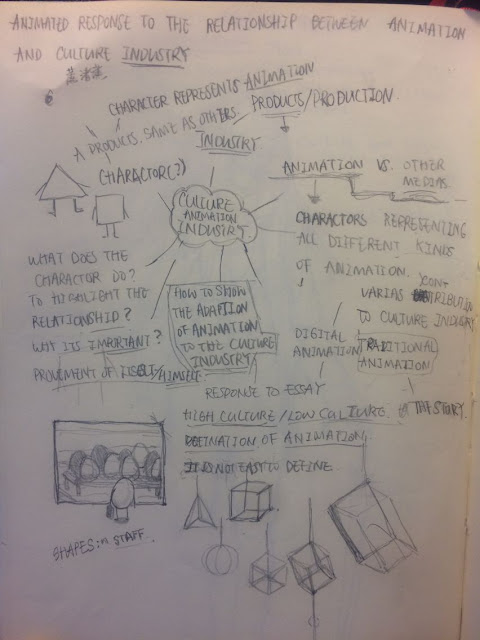A sheet of generation of ideas that the main charactor has been mass produced, and he finally found out he's just one of them. This idea has a relatively clearer storyline, however I decided to make the animation closer to an abstract film.
Thursday, 18 February 2016
Wednesday, 17 February 2016
Lecture: Colour theory
Colours stands out of contrast of backgound, therefore it can be seen by human eyes. Contrast include not only the difference of the colours, but the "warm" and "cold" of the colours as well. For example we indicates red as warm colour while orange is a less warm colour comparing to red, which differentiate orange from red.
Wednesday, 10 February 2016
Lecture: Intro of colour theory
The visible light are from the range of 700 to 400 nm, from red to purple. Human eyes detects colour with rods and cones, which are the receptor in our eyes. The rods detect shadow and lights, while the cones detect colours.
There are three kinds of cones, where one detect red and orange, the other one detect green, and the remaining one detect blue and violet. Primary colour means the colours that can be detected straight forwards with the cones, while secondary lights are the lights that's needing more than one cone to combine in order to detect the colour. The chromatic value means the luminance.
There are three kinds of cones, where one detect red and orange, the other one detect green, and the remaining one detect blue and violet. Primary colour means the colours that can be detected straight forwards with the cones, while secondary lights are the lights that's needing more than one cone to combine in order to detect the colour. The chromatic value means the luminance.
Tuesday, 9 February 2016
Study Task 2
At the very first part of the book,
Storey clarified the way we define popular culture with the term ’culture’,
where it is ’one of the two or three most complicated words in the English
Language’, suggested by Raymond Williams, it is not only restricted to a word
but a massive definition. Culture can be refer to ‘a general process of
intellectual, spiritual and aesthetic development’, yet it can represent a huge
part of the culture part of a country. He also suggested that ‘culture’ can be
interpreted as ‘a particular way of life, whether of a people, a period or a
group’. This definition is suggested when speaking of the cultural development,
analysing the evolvement through a period of time of people or groups of
people. Furthermore it is not only restricted to a narrow range of cultural
products but also literacy and religious for instance. Storey suggested that
culture is ‘synonymous with that structuralists and post-structuralists’ where
poetry novel, opera and fine art and these sorts of art usually defined as high
culture. In conclusion, popular culture usually means to ‘mobilize the second
and third meaning of the word ‘culture’’, that allow us to consider pop music,
comics and soap opera (Storey, [2008], 2).
Source: https://drive.google.com/a/students.leeds-art.ac.uk/file/d/0B-4SIkiY5HDGejBPV0lRYk82YzQ/view
Wednesday, 3 February 2016
Lecture: The Design as Social Critic
In the late age of print, Gutenberg's printing press,1440, has started the mass produce of printed products, and it is was when it spread out.
The mass image culture:
New royal academy is the first art school, the ideas of fime art and rest of creative production been trained to make historical propaganda oil painting for money purpose of famous peopel from past.
Culture and popular culture:
urbanization of royal vreses working class, making of a working class of two different cultures, which are always in confix. People starts to produce political cultures and political threads. New sorts of urban culture of selling reproduction of paintings, and starts the reproduce of art. The reproduction has chosen the simple grey scaled, as it is easier to mass produce.
Hence at that time, mass culture is everything being standatd, and traditional authority of what's good and beautiful are rebuild.
The mass image culture:
New royal academy is the first art school, the ideas of fime art and rest of creative production been trained to make historical propaganda oil painting for money purpose of famous peopel from past.
Culture and popular culture:
urbanization of royal vreses working class, making of a working class of two different cultures, which are always in confix. People starts to produce political cultures and political threads. New sorts of urban culture of selling reproduction of paintings, and starts the reproduce of art. The reproduction has chosen the simple grey scaled, as it is easier to mass produce.
Hence at that time, mass culture is everything being standatd, and traditional authority of what's good and beautiful are rebuild.
Subscribe to:
Comments (Atom)

